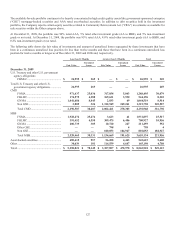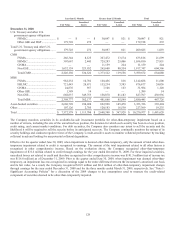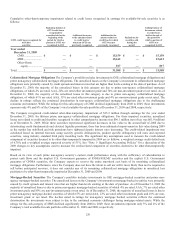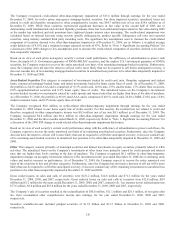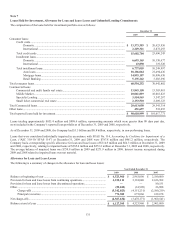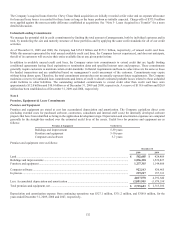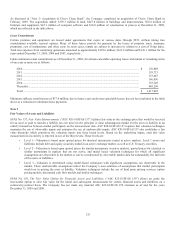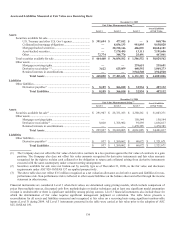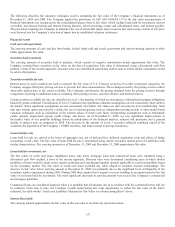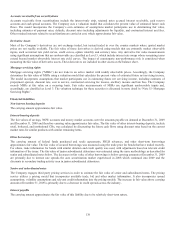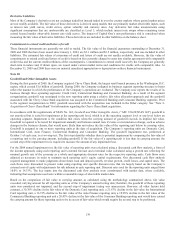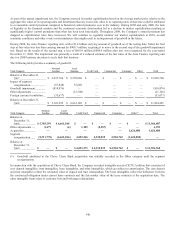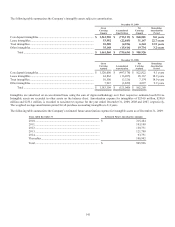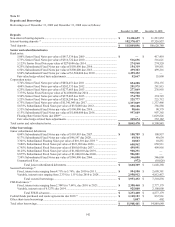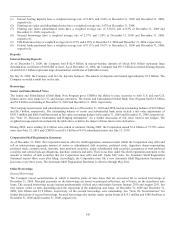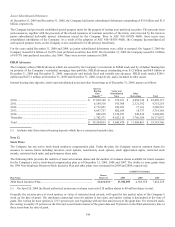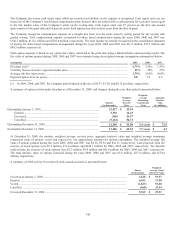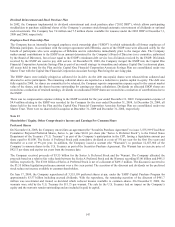Capital One 2009 Annual Report Download - page 150
Download and view the complete annual report
Please find page 150 of the 2009 Capital One annual report below. You can navigate through the pages in the report by either clicking on the pages listed below, or by using the keyword search tool below to find specific information within the annual report. 137
The following describes the valuation techniques used in estimating the fair value of the Company’s financial instruments as of
December 31, 2009 and 2008. The Company applied the provisions of ASC 820-10/SFAS 157 to the fair value measurements of
financial instruments not recognized on the consolidated balance sheet at fair value, which include loans held for investment, interest
receivable, non-interest bearing and interest bearing deposits, other borrowings, senior and subordinated notes, and interest payable.
The provisions requiring the Company to maximize the use of observable inputs and to measure fair value using a notion of exit price
were factored into the Company’s selection of inputs into its established valuation techniques.
Financial Assets
Cash and cash equivalents
The carrying amounts of cash and due from banks, federal funds sold and resale agreements and interest-bearing deposits at other
banks approximate fair value.
Securities held to maturity
The carrying amounts of securities held to maturity, which consists of negative amortization bonds, approximate fair value. The
Company recorded these securities at fair value on the date of acquisition. Fair value is determined using a discounted cash flow
method, a form of the income approach. Discount rates were determined considering market rates at which similar instruments would
be sold to third parties.
Securities available for sale
Quoted prices in active markets are used to measure the fair value of U.S. Treasury securities. For other investment categories, the
Company engages third party pricing services to provide fair value measurements. The techniques used by the pricing services utilize
observable market data to the extent available. The Company corroborates the pricing obtained from the pricing services through
comparison of pricing to additional sources, including other pricing services, securities dealers, and internal sources.
Certain securities available for sale are classified as Level 3, the majority of which are non-agency collateralized mortgage obligations
backed by prime collateral. Classification of Level 3 indicates that significant valuation assumptions are not consistently observable in
the market. When significant assumptions are not consistently observable, fair values are derived using the best available data. Such
data may include quotes provided by a dealer, the use of external pricing services, independent pricing models, or other model-based
valuation techniques such as calculation of the present values of future cash flows incorporating assumptions such as benchmark
yields, spreads, prepayment speeds, credit ratings, and losses. As of December 31, 2009, we saw significant improvements in
the market value of our portfolio holdings driven by stabilization of the financial markets, reduced risk premiums and a general
decline in interest rates as compared to 2008. The decrease in the amount of Level 3 securities reflected continued runoff of the
securities, the liquidation of the Company’s CMBS securities, and improvement in pricing consistency.
Loans held for sale
Loans held for sale are carried at the lower of aggregate cost, net of deferred fees, deferred origination costs and effects of hedge
accounting, or fair value. The fair value of loans held for sale is determined using current secondary market prices for portfolios with
similar characteristics. The carrying amounts as of December 31, 2009 and December 31, 2008 approximate fair value.
Loans held for investment, net
The fair values of credit card loans, installment loans, auto loans, mortgage loans and commercial loans were estimated using a
discounted cash flow method, a form of the income approach. Discount rates were determined considering rates at which similar
portfolios of loans would be made under current conditions and considering liquidity spreads applicable to each loan portfolio based
on the secondary market. The fair value of credit card loans excluded any value related to customer account relationships. The
decrease in fair value below carrying amount at December 31, 2008 was primarily due to the significant level of illiquidity in the
secondary market experienced during 2008. During 2009 these markets have begun to recover resulting in an improvement in the fair
value of our loans held for investment. The most significant discounts to carrying amount were seen in the Company’s commercial
and mortgage portfolios.
Commercial loans are considered impaired when it is probable that all amounts due in accordance with the contractual terms will not
be collected. From time to time, the Company records nonrecurring fair value adjustments to reflect the fair value of the loan’s
collateral. See table within “Assets and Liabilities Measured at Fair Value on a Nonrecurring Basis” above.
Interest Receivable
The carrying amount approximates the fair value of this asset due to its relatively short-term nature.


